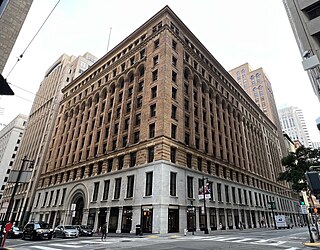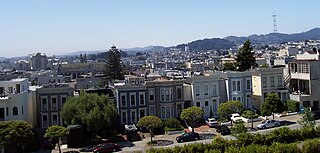
Japantown is a neighborhood in the Western Addition district of San Francisco, California.

Bernard Ralph Maybeck was an American architect in the Arts and Crafts Movement of the early 20th century. He was an instructor at University of California, Berkeley. Most of his major buildings were in the San Francisco Bay Area.

Russian Hill is a neighborhood of San Francisco, California. It is named after one of San Francisco's 44 hills, and one of its original "Seven Hills".

The Hallidie Building is an office building in the Financial District of San Francisco, California, at 130 Sutter Street, between Montgomery Street and Kearny Street. Designed by architect Willis Polk and named in honor of San Francisco cable car pioneer Andrew Smith Hallidie, it opened in 1918. Though credited as the first American building to feature glass curtain walls, it was in fact predated by Louis Curtiss's Boley Clothing Company building in Kansas City, Missouri, completed in 1909.

Ephraim Willard Burr (1809–1894) was an American businessman, banker, and politician. He served as the 8th mayor of San Francisco, California, from 1856 to 1859.

The Bridgeport Covered Bridge is located in Bridgeport, Nevada County, California, southwest of French Corral and north of Lake Wildwood. It is used as a pedestrian crossing over the South Yuba River. The bridge was built in 1862 by David John Wood. Its lumber came from Plum Valley in Sierra County, California. The bridge was closed to vehicular traffic in 1972 and pedestrian traffic in 2011 due to deferred maintenance and "structural problems".

San Juan Bautista State Historic Park is a California state park encompassing the historic center of San Juan Bautista, California, United States. It preserves a significant concentration of buildings dating to California's period of Spanish and Mexican control. It includes the Mission San Juan Bautista, the Jose Castro House, and several other buildings facing the historic plaza. It became a state park in 1933 and was declared a National Historic Landmark in 1970. It is also a site on the Juan Bautista de Anza National Historic Trail.

The Feusier Octagon House is an historic octagonal house built in c. 1857, and located in the Russian Hill neighborhood of San Francisco, California.

Albert Pissis (1852–1914) was a prolific Mexican-born American architect, of French and Mexican descent. He was active in San Francisco and had studied at the École des Beaux-Arts in Paris, France. He is credited with introducing the Beaux-Arts architectural style to San Francisco, California, designing a number of important buildings in the city in the years before and after the 1906 San Francisco earthquake.

The Mills Building and Tower is a two-building complex following the Chicago school with Romanesque design elements in the Financial District of San Francisco, California. The structures were declared San Francisco Designated Landmark #76, and were listed on the National Register of Historic Places in 1974.

St. Joseph's Church and Complex is a historic church built in 1906, and located at 1401–1415 Howard Street in the South of Market neighborhood of San Francisco, California, United States.
Frederick Herman Meyer was an American architect. He was active in the San Francisco Bay Area, and is known for designing the YMCA Hotel in San Francisco. From c.1898 until 1901, Samuel Newsom worked with Meyer, to form the firm Newsom and Meyer in Oakland. Starting in 1902 and until 1908, Meyer entered into a partnership with architect Smith O'Brien to form the form Meyer and O'Brien.

The Nathanial Brittan Party House, also known as Nathaniel Brittan Party House,Brittan Party House, Brittan Lodge, is located at 125 Dale Avenue in San Carlos, California, and was built in 1872. It was listed on the National Register of Historic Places in 1994.

The Frank G. Edwards House is a historic residential building built in 1883, and located at 1366 Guerrero Street in the Noe Valley section of San Francisco, California.

The Russian Hill-Paris Block Architectural District is a 1.5-acre (0.61 ha) historic district located in the Russian Hill area of San Francisco, California, that was listed on the National Register of Historic Places on January 7, 1988, for architecture. The area is a residential enclave.

The Vollmer House is a historic house built between 1876 and 1885, and located in the Japantown area in San Francisco, California. The house is known for its outstanding decorative details on the exterior.

The Liberty Hill Historic District is a historic district located in the Dolores Heights neighborhood of San Francisco, California, U.S.. It is a residential neighborhood bound by 20th, Mission, Dolores, and 22nd Streets. It is listed as a San Francisco Designated Landmark since October 25, 1985.

The Uptown Tenderloin Historic District is a historic district located in the Tederloin neighborhood of San Francisco, California, U.S.. It has 408 contributing buildings and covers roughly a 33-city block radius in downtown San Francisco. The Uptown Tenderloin Historic District was listed on the National Register of Historic Places on February 5, 2009, for architecture and social history.























